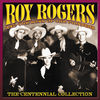Roy Rogers
Biography
When Cincinnati-born Leonard Franklin Slye headed west in the spring of 1931, it was as a would-be musician, working jobs ranging from driving a gravel truck to picking fruit in California's Central Valley. In less than two years, he'd co-founded the greatest Western singing group of all time, the Sons of the Pioneers, and barely four years after that, he'd started a career as a movie star under the new name Roy Rogers. Ultimately he found great fame as a movie and TV cowboy and even founded a very successful chain of restaurants.. He was born in Cincinnati, OH, the son of Andrew and Mattie Womack Slye. The entire household was musical, and by the time he was a teenager, Len could play the guitar and the mandolin. Although he later took on the role of a cowboy before the public, the closest he got to riding the range was working the family farm they had in a small town outside of Cincinnati. By age 19, he'd headed out to California, where chance led him to enter an amateur singing contest on the radio, resulting in an offer to join the Rocky Mountaineers. There he made the acquaintance of Bob Nolan. They developed a harmonious friendship that worked well within the group for several months, until Nolan exited in frustration over their lack of success. His replacement was Tim Spencer, and eventually Slye, Spencer, and another singer named Slumber Nichols quit the Rocky Mountaineers in the spring of 1932 to form a trio of their own, which never quite came off. Slye decided to push on, joining Jack LeFevre & His Texas Outlaws.
Top Albums |

1. The Centenni..
 | 
2. Slideways
 | 
3. Ride Ranger ..
 | 
4. Country Musi..
 | 
5. A Blue Thing
 |

6. Home On The ..
 | 
7. Tumbling Tum..
 | 
8. 16 Great Son..
 | 
9. Texas Crapsh..
 | 
10. Christmas Is..
 |

11. Roy Rogers
 | 
12. Roy Rogers, ..
 | 
13. A Cowboy's S..
 | 
14. Happy Trails..
 | 
15. Don't Fence ..
 |

16. Hi Ho Silver
 | 
17. Texas Moon
 | 
18. Roy Rogers -..
 | 
19. An Old Cowha..
 | 
20. The All Time..
 |
|
Top Songs |
| Name | Album | Time | Price | |
| 1. | Happy Trails | Happy Trails To You | 2:15 | $1.29 |  |
| 2. | Don't Fence Me In | Ride Ranger Ride | 2:52 | $0.99 |  |
| 3. | Hadie Brown (My Little Lady) | Centennial Collection | 2:33 | $1.29 |  |
| 4. | Jesse James | Centennial Collection | 4:02 | $1.29 |  |
| 5. | Frosty the Snowman | Swinging Christmas - With F.. | 2:22 | $0.99 |  |
| 6. | Frosty the Snowman | Big Band Christmas - Happy .. | 2:22 | $0.99 |  |
| 7. | Yellow Rose of Texas | Classic Country and Western.. | 2:39 | $0.99 |  |
| 8. | Yellow Rose of Texas | Patriotic American Country .. | 2:39 | $0.99 |  |
| 9. | Yellow Rose of Texas | They Don't Make 'Em.. | 2:39 | $0.99 |  |
| 10. | Yellow Rose of Texas | American Beauty - A Country.. | 2:39 | $0.99 |  |
| 11. | Yellow Rose of Texas | Big Iron - The Best of Cowb.. | 2:39 | $0.99 |  |
| 12. | Roll On Texas Moon | Timeless Country: Rhythm On.. | 2:33 | $0.99 |  |
| 13. | Jessica | Midnight Rider - A Tribute .. | 7:30 | $0.99 |  |
| 14. | Good News, Bad News | Happy Trails To You | 2:54 | $1.29 |  |
| 15. | Cold, Cold Heart | Happy Trails To You | 2:27 | $1.29 |  |
| 16. | Movie Trail Medley: On the Old Spani.. | Happy Trails To You | 5:15 | $1.29 |  |
| 17. | Don't Cry Baby | Happy Trails To You | 2:35 | $1.29 |  |
| 18. | Tennessee Stud | Happy Trails To You | 3:06 | $1.29 |  |
| 19. | Hoppy, Gene and Me | Happy Trails To You | 2:42 | $1.29 |  |
| 20. | Very Fine Lady | Happy Trails To You | 2:16 | $1.29 |  |
| 21. | Cowboy Heaven | Happy Trails To You | 2:53 | $1.29 |  |
| 22. | Pecos Bill | Breakin' in Another Hea.. | 3:09 | $0.99 |  |
| 23. | Pecos Bill | Silly, Funny Country Songs:.. | 3:09 | $0.99 |  |
| 24. | Pistol Packin' Mama | Classic Folk Masters | 1:25 | $0.99 |  |
| 25. | Christmas on the Plains | Songs of Christmas Past | 2:34 | $0.99 |  |

